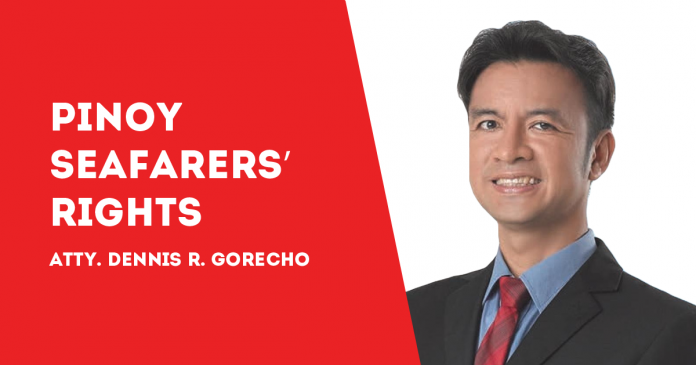
THE SEAFARER’S recovery from his illness or injury will not negate his entitlement to total permanent disability benefits.
Total disability does not mean absolute helplessness since it is the not the injury which is compensated but rather the incapacity to work resulting in the impairment of one’s earning capacity.
The Supreme Court reiterated this principle in the case of Sealanes Marine Services, Inc vs Arnel dela Torre (G.R. No. 214132, Feb. 18, 2015). It stressed that it is of no consequence that the seafarer was cured after a couple of years in connection with his disability compensation.
The seafarer was medically repatriated after he suffered a lower back injury due to an accident during the crew’s rescue boat drill on Aug. 1, 2010.
After undergoing several physical therapy sessions, the company-designated physician finally assessed the seafarer on March 10, 2011 with a Grade 11 disability for slight rigidity or one-third loss of motion or lifting power of trunk. He was informed of the assessment, however, only in May 2011, or more than 240 days since the accident.
The Supreme Court affirmed earlier rulings by the National Labor Relations Commission (NLRC) and Court of Appeals that the seafarer was entitled to total disability benefits as he continued with his rehabilitation even after the company’s Grade 11 disability rating issued on March 10, 2011.
The disability rating was intended merely to comply with the 240-day limit for the company-designated physician to either declare him fit to work or to assess the degree of his permanent disability.
The medical assessment of the company-designated physician is not the alpha and the omega of the seafarer’s claim for permanent and total disability.
The Supreme Court explained that the Philippine Overseas Employment Administration Standard Employment Contract (POEA SEC) provides merely for the basic or minimal acceptable terms of the contract.
In the assessment of whether his injury is partial and permanent, the same must be so characterized not only under the Schedule of Disabilities in Section 32 of the POEA SEC, but also under the relevant provisions of the Labor Code and the AREC implementing Title II, Book IV of the Labor Code.
In Kestrel Shipping Co., Inc. vs Munar (G.R. No. 198501, Jan. 30, 2013), the Supreme Court explained that:
(a) the 120 days provided under Section 20(B)(3) of the POEA SEC is the period given to the employer to determine fitness to work and when the seafarer is deemed to be in a state of total and temporary disability;
(b) the 120 days of total and temporary disability may be extended up to a maximum of 240 days should the seafarer require further medical treatment; and
(c) a total and temporary disability becomes permanent when so declared by the company-designated physician within 120 or 240 days, as the case may be, or upon the expiration of the said periods without a declaration of either fitness to work or permanent disability and the seafarer is still unable to resume his regular seafaring duties.
The company tried to contest the award by showing that seafarer was able to work again as a chief mate in March 2001.
The Supreme Court disregarded the company’s argument as it reiterated its ruling in Crystal Shipping, Inc. vs Natividad (G.R. No. 154798, Oct.2 0, 2005) that it is of no consequence that the seafarer recovered from his illness or injury.
The information does not alter the fact that as a result of his illness, the seafarer was unable to work as a chief mate for almost three years.
The Court stressed what the law does not require that the illness should be incurable.
What is important is that he was unable to perform his customary work for more than 120/240 days, and this constitutes total permanent disability.
Back pains or spine injuries or illnesses are inherent in a seafarer’s job characterized by excessive and strenuous physical activities, such as lifting, carrying, pushing, pulling and moving heavy equipment and materials.
The common back injuries or illness include lumbar spondylosis, lumbar radiculopathy, multi-level disc desiccation, posterior disc herniation, or canal stenosis.
Companies cannot deny the fact that a seafarer suffering from any of these medical conditions will be considered more of a liability than an asset if he is allowed to go on board the vessel.
He would no longer be able to perform strenuous activities such as the rigorous duties of a seafarer.
An award of a total and permanent disability benefit would be germane to the purpose of the benefit, which is to help the employee in making ends meet at the time when he is unable to work.
***
Atty. Dennis R. Gorecho heads the seafarers’ division of the Sapalo Velez Bundang Bulilan law offices. For comments, email info@sapalovelez.com, or call 09175025808 or 09088665786)./PN


